About 100 volunteers ranging from elementary school students to grandparents line up twice a year along the Intracoastal Waterway in St. James, North Carolina, under the intense sun and ankle-deep in muck. They move hundreds of bags of oyster shells, bucket-brigade style, to extend what has become known as a living shoreline, designed to stem erosion and pollution from the constant stream of boat traffic.
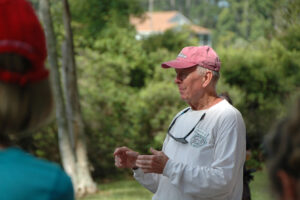
J. Taylor Ryan (’62, P’96), leader of St. James’ living shoreline effort
“Every oyster cleans 30 to 50 gallons of water a day — that’s bathtub size,” says J. Taylor Ryan (’62, P ’96), who instigated the first oyster-reef build in 2005. He has kept the work going for 18 years and continues to gather momentum. Along with the retirees who make up the project’s backbone, participants each summer include teenagers from a nearby coastal-studies camp and family members visiting St. James residents. In the fall, area high school students reinforce the project’s stalwarts.
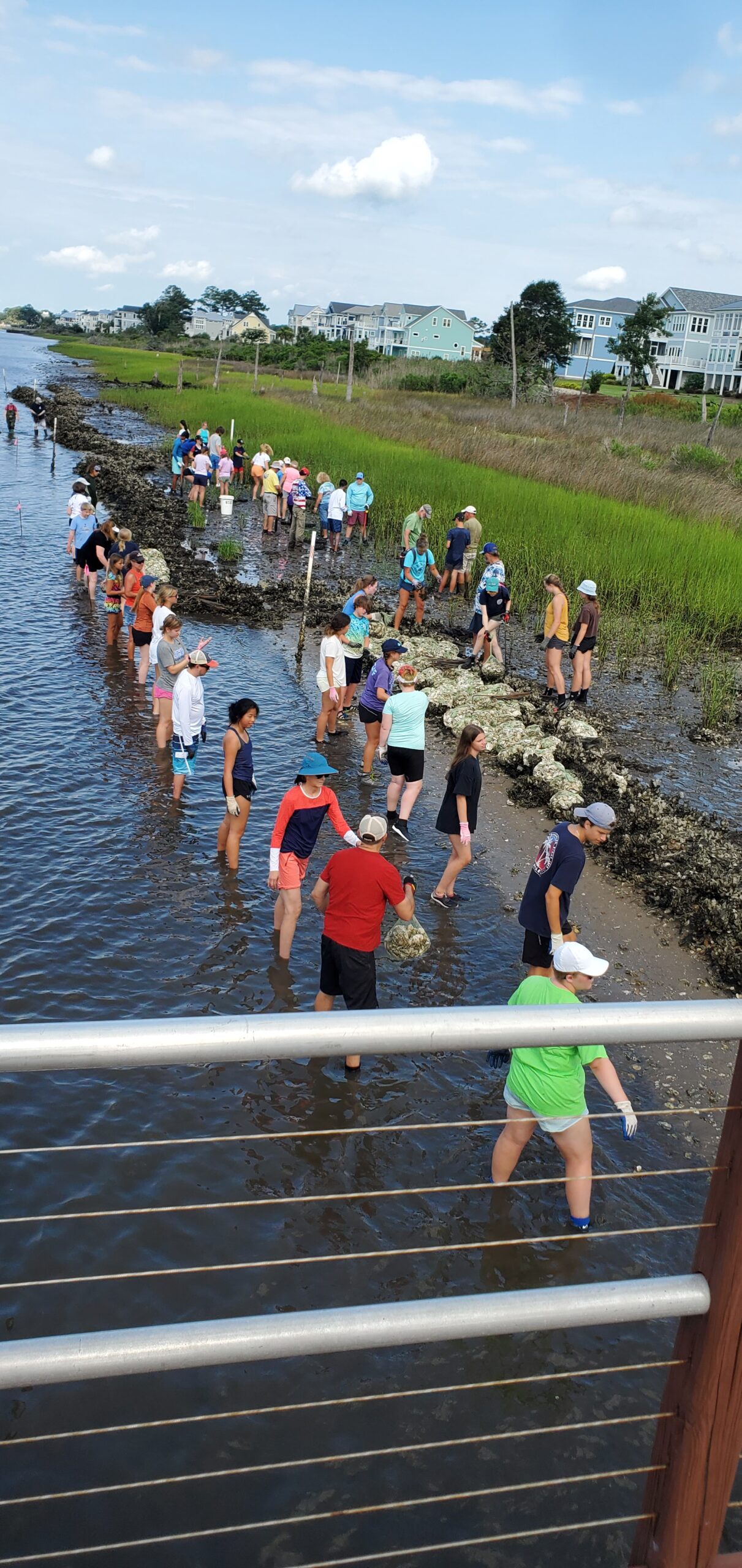
More than 100 volunteers gather twice a year to extend the living shoreline they are building from bagged oyster shells in St. James, North Carolina, along the Intracoastal Waterway.<br /> Photos courtesy of J. Taylor Ryan (’62, P’96)
Their barrier now spans at least 700 feet in St. James’ Waterway Park, and Ryan hopes to add another 2,500 feet. University of North Carolina Wilmington students regularly research its impact. (For example, where no oysters lived 18 years ago, there are now more than 600 per square meter.) And the St. James Conservancy, formed two years ago, is bringing together the living shoreline work with other environmental initiatives including a bird rescue group and turtle watch.
The project’s spark came a few years after Ryan moved in 2001 from New Jersey to a home fronting the Intracoastal Waterway. He was struck by the continuous boat traffic he watched from his backyard — sometimes as many as 100 vessels an hour — and the resulting erosion and pollution.
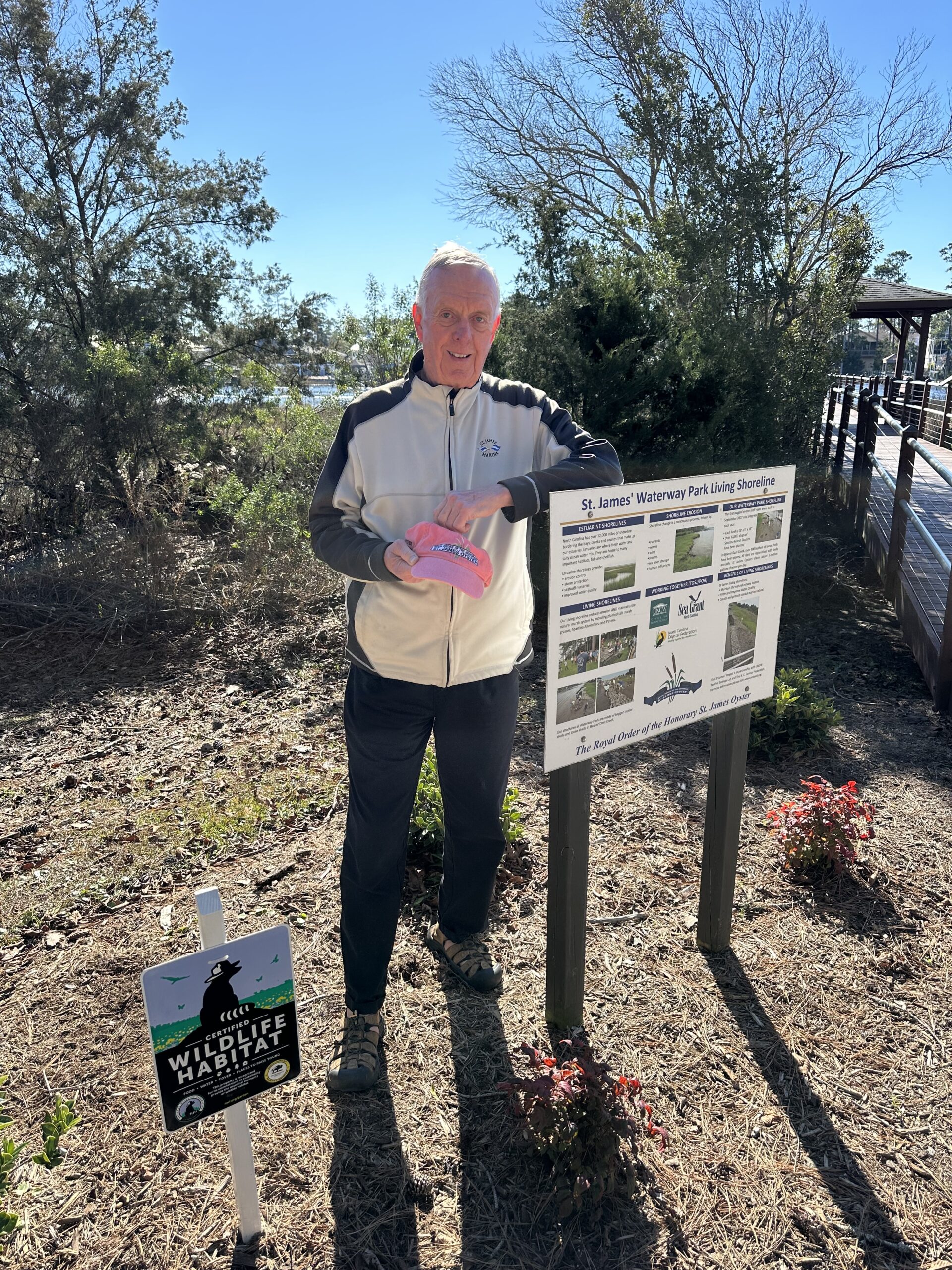
As part of Ryan's efforts to expand the living shoreline, he led the creation of the St. James Conservancy.
Through one of the many local fishing and conservation groups he had joined, he found a daylong seminar in 2005 on the ways oysters can improve the coastline’s health. When people return oyster shells to the water, baby oysters settle on them and go to work as natural filters. Bagged oyster shells and marsh grasses installed together can reduce boat wake damage and restore a natural habitat that otherwise might be lost. The idea is that the living shoreline grows over time, creating a more natural solution to shoreline erosion and pollution, while improving marine life, rather than building a concrete sea wall.
Oyster-reef restoration is critical along the North Carolina coast, Ryan learned, both to deal with depleted oyster populations and also hydrology issues. And human-made oyster reefs can work just as well as natural ones to protect coastal marsh and shorelines, stabilize sediment, enhance the habitat for fish and shellfish and improve water quality through the filtering capabilities of the salt marsh grasses and oysters, according to the North Carolina Coastal Federation’s Oyster Restoration and Protection Plan for North Carolina.
“Every oyster cleans 30 to 50 gallons of water a day — that’s bathtub size.”
After learning that volunteers could build living shorelines themselves, Ryan used the networking skills he had developed during a career in sales at IBM to get the project going. (He had a long-time interest in the environment as well, having served as a wilderness guide at scout camp and commanding a company in charge of three ships on the Chesapeake Bay as a U.S. Army officer upon graduating from Wake Forest. In fact, Ryan had considered majoring in biology over business as an undergraduate but was dissuaded by the German language requirement.)
Ryan reached out to Troy Alphin, a senior research associate at the Benthic Ecology Laboratory, part of UNCW’s Center for Marine Science. Alphin says he encouraged Ryan, suggesting: “Why don’t you become a citizen scientist? We’ll help you build a reef, and you can help us collect the data?”
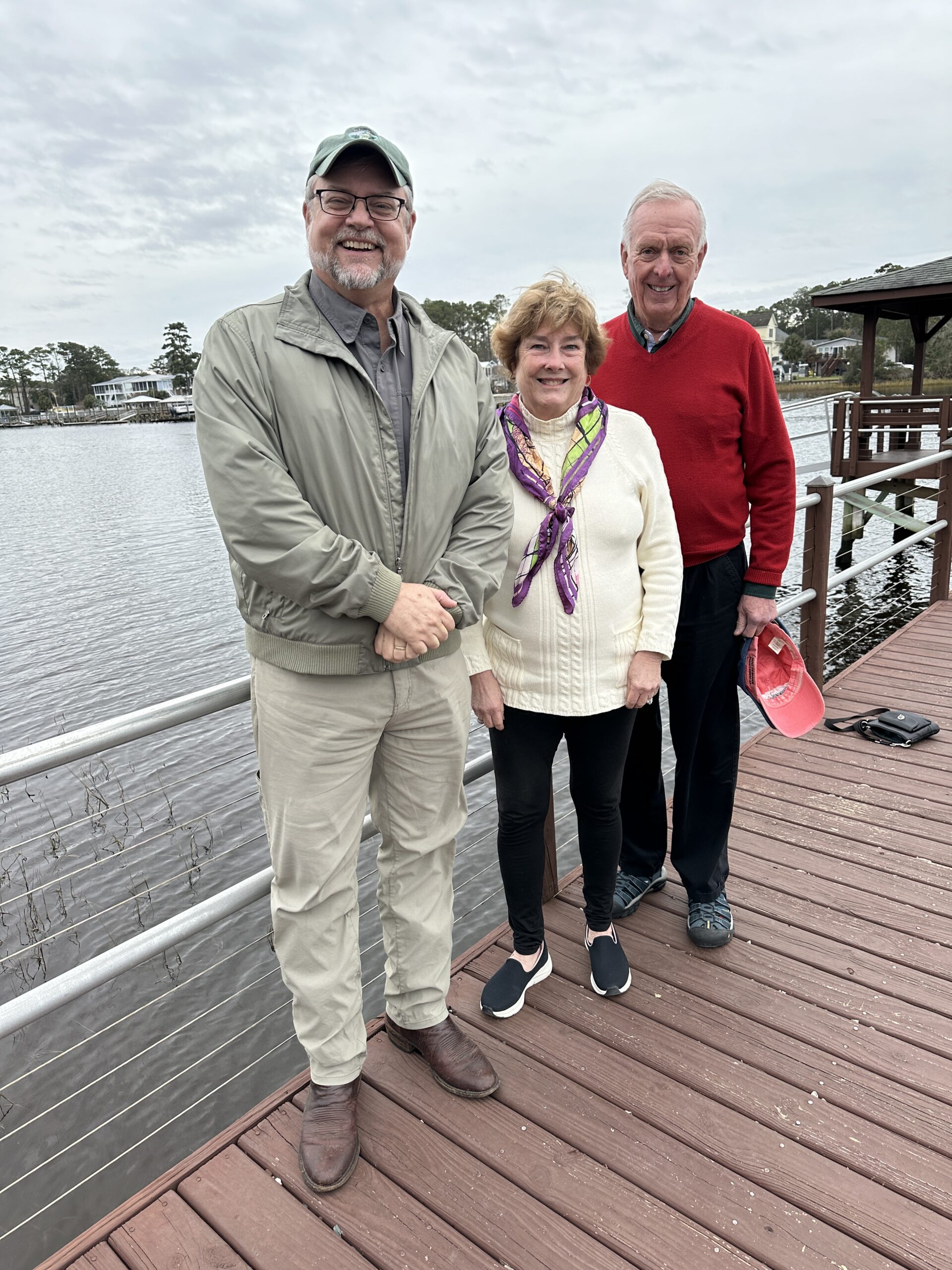
Troy Alphin, a senior research associate at the Benthic Ecology Laboratory, part of UNCW’s Center for Marine Science, with Lucy Greene Williams ('76) and Ryan
With that encouragement, Ryan approached St. James’ mayor at the time, Shelley Lesher, now deceased, whom he asked how he might apply for a $5,000 grant to rent a loader and buy oyster shells. She pledged the money on the spot.
“I thought, ‘Uh oh, what do I do now?’” Ryan recalls with a chuckle, because he had expected to have time to figure it out while rounding up funding. He quickly sought advice from the North Carolina Coastal Federation and UNCW on how to buy 21 cubic yards of oyster shells and sent an email “to everybody in town asking for volunteers to bag shells.” At the time, St. James had about 1,500 residents, and 94 people showed up.
Alphin, who was on vacation the day Ryan’s volunteers were set to gather, remembers thinking a dozen people might come and that he would swing by to talk to them for a few minutes. He was stunned to see eight times that number — and to watch them fill 1,500 bags with oysters in three hours, something that had taken other communities three months to do.
After the volunteers bag the shells, they have to wait six to 12 weeks to return them to the water to attract larvae floating with the tide and seeking a hard surface. When they find the shells, they attach – and from there, the oysters grow and make more shells on their own, Ryan says. About six weeks after the St. James volunteers had built their first 50 feet of reef, about three-quarters of a million oysters were growing, inspiring the newly minted team of citizen scientists to keep going.
“Taylor was really ahead of his time in identifying what he felt was important in protecting the shoreline, and he has a great deal of energy."
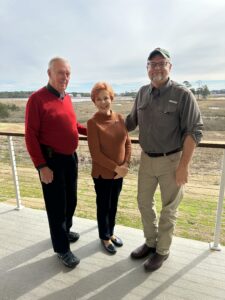
Ryan, Mayor Jean Toner, Alphin
The project soon galvanized into the “Royal Order of the Honorary St. James Oyster,” which is heading into its 19th year with as many as 160 volunteers at builds planned around low tides, typically in July and October. The local sheriff’s marine patrol helps slow down boats to minimize wakes. And St. James’ town government has continued to support the project financially, including funding UNCW interns. In fact, the university recognized Alphin and the town of St. James for “Excellence in Community Engagement” in 2022.
“Taylor was really ahead of his time in identifying what he felt was important in protecting the shoreline, and he has a great deal of energy,” Mayor Jean Toner says. “He really is amazing in how he developed this nice partnership.”
Ryan’s gift for bringing like-minded groups together also led to the creation of the St. James Conservancy, whose 130 members are working on ways to expand the town’s designation as a UNCW research sanctuary and bird sanctuary to becoming a certified wildlife habitat as well, among other initiatives. Jan. 3 marked its second anniversary.
One of Ryan’s early recruits was Lucy Greene Williams (’76), who first connected with Ryan when they were both volunteering as part of a turtle-watch team at Caswell Beach. She, too, had worked at IBM, so while keeping an eye on turtle nests for signs of hatching, they shared stories and Ryan asked her to join the living shoreline crew. “When I started out, I was carrying the shells and planting the grasses,” she says. “My friend’s whole tennis shoe stayed stuck in the mud. I would come home and want to throw away my clothes, we got so dirty.”
These days, she serves pizza and cookies to volunteers and admires how Ryan “works the crowd. He gets the (local) folks volunteering to meet the campers, because these kids come from all over the country. He’s gotten the town involved in supporting the research. Our clubs give us the food. And he has such a phenomenal relationship with the folks at UNCW,” she says.
“There’s a lot of value in what Taylor and St. James are doing and the way they’re doing it, because it promotes societal awareness about resiliency — and how we can damage or repair the environment."
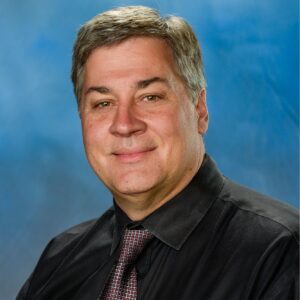
Kenneth Halanych (’88)
Kenneth M. Halanych (’88), a biology major who has become a prolific marine invertebrate scientist, became executive director of UNCW’s Center for Marine Science two years ago — and soon met Ryan, “wearing his Wake paraphernalia,” at an evening seminar. “The power of the living reef is that it stabilizes the sediment. They also dissipate the currents and the wave actions,” Halanych says. “There’s a lot of value in what Taylor and St. James are doing and the way they’re doing it, because it promotes societal awareness about resiliency — and how we can damage or repair the environment.
“And the big piece here is the great collaboration between university scientists and the lay public,” he says.
Ryan has recruited students to Wake Forest as well, including Alphin’s daughter, Kathryn Alphin (MS ’22), who started helping with the oyster-reef builds around age 6 or 7. “It was super fun,” she says. “I didn’t quite understand what was going on at such a young age, but I knew it was helping the earth, helping my home and helping Dad.”
She continued to work on the living shoreline builds in high school, and Ryan encouraged her to attend the speaker series he organized around environmental issues and current events. Later, he wrote a recommendation letter for her application to Wake Forest’s master’s program in health and exercise science.

Volunteers distribute the oyster shells "bucket-brigade" style, passing heavy bags down the line often while ankle-deep in muck.
Seeing many generations working together to save the coastline is “the coolest thing about the project,” Williams, the alumna who volunteers alongside Ryan, says. “At Wake, I was a religion major, and then I had a career in tech. I had always wanted to make a difference, and so did Taylor.”
Now, the waterway beyond Ryan’s backyard has shown measurable improvement. UNCW interns using gauges and drones to track the movement of silt have documented progress. More than 36 species have colonized the living shoreline, including multiple types of crabs, gastropods, mussels, amphipods and shrimp, Alphin says. More than 48 species of nekton (actively swimming aquatic fauna) also have moved in, including juvenile stages of finfish such as red drum.
And even when Hurricane Florence battered St. James in September 2018, the oyster shells “stabilized the coastline,” rather than its suffering erosion, Ryan says proudly. “The living shoreline did exactly what it was supposed to do.”


